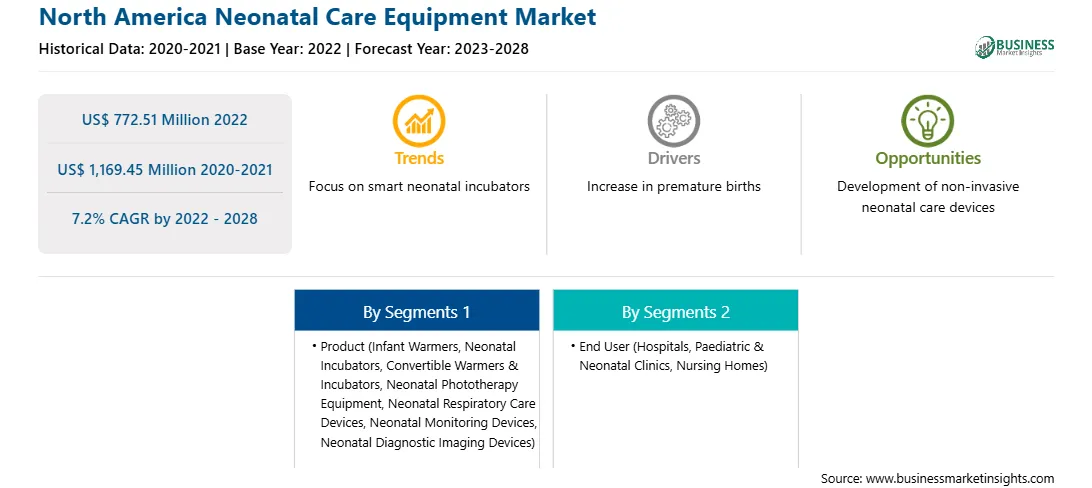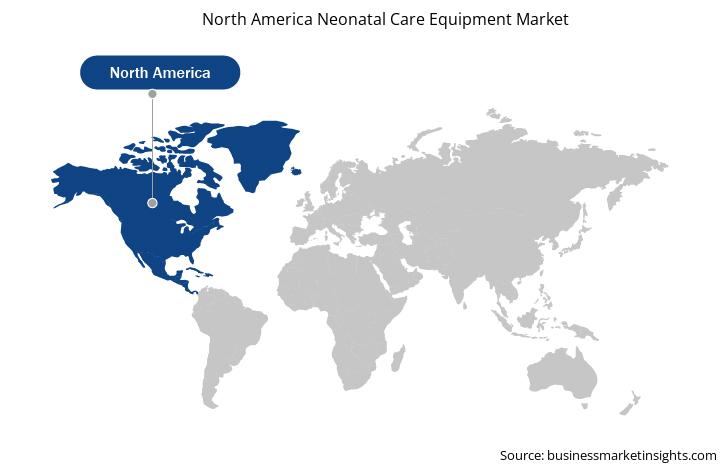The neonatal care equipment market in North America is expected to grow from US$ 772.51 million in 2022 to US$ 1,169.45 million by 2028; it is estimated to grow at a CAGR of 7.2% from 2022 to 2028.
Rising Number of Premature and Low Weight Births
Many complications are associated with prematurity, resulting in neonatal deaths. According to the Centers for Disease Control and Prevention, an article titled "Preterm Birth" published in November 2021 reported that 1 in 10 children born in 2020 was born prematurely in the US. Preterm birth remains a significant public health problem, contributing to 75% of neonatal mortality. Low birth weight (LBW) is an important but imperfect surrogate for preterm birth when the accurate determination of gestational age is impossible. While there is overlap between preterm births and LBW newborns, those who are both preterm and LBW are at the highest risk for adverse neonatal outcomes. Also, the increasing prevalence of hypothermia in preterm infants is a significant public health concern. The World Health Organization reported it as a leading cause of neonatal mortality and morbidity. Common causes of premature birth are infections, chronic diseases such as high blood pressure and diabetes, and multiple pregnancies; however, often, no cause is identified. Therefore, the increasing number of preterm births and increased survival concerns are fueling the demand for neonatal care equipment to manage the complications associated with preterm birth.
Market Overview
The North American neonatal care equipment market is segmented into the US, Canada, and Mexico. The regional market is expected to grow owing to the growing number of initiatives from the public and private sectors to enhance patient care and increase the number of neonatal care facilities in the region. However, the rising expense of newborn care is expected to restrain the market growth in the coming years.
The cases of preterm birth have increased in the last few years in the US. According to the Center for Disease Control and Prevention (CDC) in 2019, the preterm birth rate rose for the fifth year in a row to 10.23%, up 2% from 10.02% in 2018, in the US. Preterm births are a serious health problem in the US, and one of the leading causes of infant mortality in the country. They account for nearly 13% of all births and 17% of all infant deaths and cost more than US$ 25 billion annually. The condition is on an alarming rise due to factors such as induced fertility, poor prenatal care, increasing maternal age, obesity, and smoking. Maternal age is one of the biggest risk factors for preterm birth. The rate of preterm birth is in the youngest and oldest mothers in the US. As per the March of Dimes Foundation, during 2010–2020, preterm birth rates were highest among women 40 and older (14.5%), followed by women under age 20 (10.4%) in the US. Preterm infant care products can be life-critical in these circumstances as they provide the thermal support necessary for survival.
The neonatal care equipment market in the US is expected to grow owing to a huge demand for technologically advanced products ensuring better healthcare delivery for newborns. The value-based healthcare model has led to the development of well-equipped NICU centers along with an increasing number of approvals for newborn care devices from the FDA. Furthermore, the launch and approval of advanced, next-generation devices in the country. For instance, in May 2021, Medtronic launched SonarMed airway monitoring system. The device continuously checks for endotracheal tube obstruction and position for neonates and infants providing immediate, actionable intelligence for clinicians.
North America Neonatal Care Equipment
Market Revenue and Forecast to 2028 (US$ Million)
Strategic insights for the North America Neonatal Care Equipment provides data-driven analysis of the industry landscape, including current trends, key players, and regional nuances. These insights offer actionable recommendations, enabling readers to differentiate themselves from competitors by identifying untapped segments or developing unique value propositions. Leveraging data analytics, these insights help industry players anticipate the market shifts, whether investors, manufacturers, or other stakeholders. A future-oriented perspective is essential, helping stakeholders anticipate market shifts and position themselves for long-term success in this dynamic region. Ultimately, effective strategic insights empower readers to make informed decisions that drive profitability and achieve their business objectives within the market. The geographic scope of the North America Neonatal Care Equipment refers to the specific areas in which a business operates and competes. Understanding local distinctions, such as diverse consumer preferences (e.g., demand for specific plug types or battery backup durations), varying economic conditions, and regulatory environments, is crucial for tailoring strategies to specific markets. Businesses can expand their reach by identifying underserved areas or adapting their offerings to meet local demands. A clear market focus allows for more effective resource allocation, targeted marketing campaigns, and better positioning against local competitors, ultimately driving growth in those targeted areas.North America Neonatal Care Equipment Strategic Insights

North America Neonatal Care Equipment Report Scope
Report Attribute
Details
Market size in 2022
US$ 772.51 Million
Market Size by 2028
US$ 1,169.45 Million
Global CAGR (2022 - 2028)
7.2%
Historical Data
2020-2021
Forecast period
2023-2028
Segments Covered
By Product
By End User
Regions and Countries Covered
North America
Market leaders and key company profiles
North America Neonatal Care Equipment Regional Insights

North America Neonatal care equipment Market Segmentation
The North America neonatal care equipment market is segmented into product, end user, and country. The North America neonatal care equipment market, based on product, is categorized into infant warmers, convertible warmers & incubators, neonatal diagnostic imaging devices, neonatal respiratory care devices, neonatal monitoring devices, neonatal incubators, neonatal phototherapy equipment, and other products. The neonatal respiratory care devices segment is likely to hold the largest share of the market in 2022.
The North America neonatal care equipment market, by end user, is fragmented into hospitals, paediatric & neonatal clinics, and nursing homes. The hospitals segment held the largest share of the market in 2022.
From country point of reference, the North America neonatal care equipment market is segmented into the US, Canada, and Mexico. The US dominated the market in 2022.
BD, Dragerwerk AG & Co. KGaA, Fisher & Paykel Healthcare Limited., GE Healthcare, Koninklijke Philips N.V., Masimo, Medtronic, Natus Medical Incorporated, and Nihon Kohden Corporation
are among the leading companies operating in the neonatal care equipment market in the region.
The North America Neonatal Care Equipment Market is valued at US$ 772.51 Million in 2022, it is projected to reach US$ 1,169.45 Million by 2028.
As per our report North America Neonatal Care Equipment Market, the market size is valued at US$ 772.51 Million in 2022, projecting it to reach US$ 1,169.45 Million by 2028. This translates to a CAGR of approximately 7.2% during the forecast period.
The North America Neonatal Care Equipment Market report typically cover these key segments-
The historic period, base year, and forecast period can vary slightly depending on the specific market research report. However, for the North America Neonatal Care Equipment Market report:
The North America Neonatal Care Equipment Market is populated by several key players, each contributing to its growth and innovation. Some of the major players include:
The North America Neonatal Care Equipment Market report is valuable for diverse stakeholders, including:
Essentially, anyone involved in or considering involvement in the North America Neonatal Care Equipment Market value chain can benefit from the information contained in a comprehensive market report.